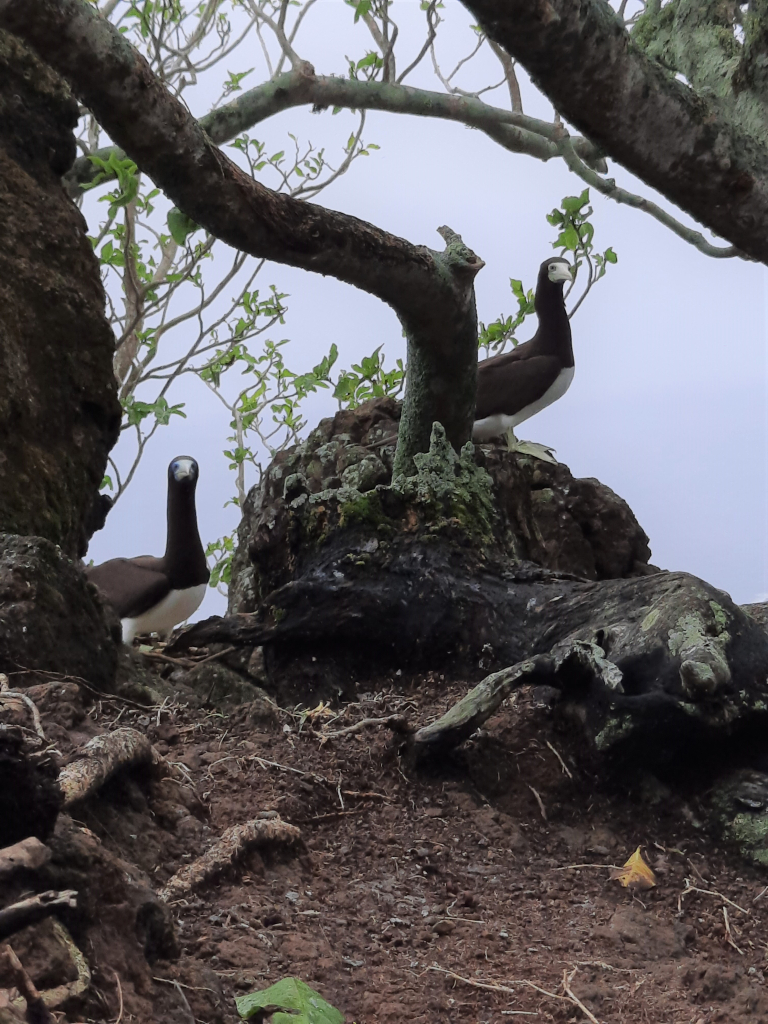
A research team from Samoa’s Ministry of Natural Resources and Environment(MNRE), the Samoa Conservation Society (SCS) and the Secretariat of the Pacific Regional Environment Programme (SPREP) accompanied by Aotearoa NZ seabird expert Chris Gaskin undertook a seabird survey on Nuútele Island, 1.3 kms off Upolu, Samoa this week. The rugged forested island is the largest of the four islands in the Aleipata Marine Protected Area and supports a range of breeding seabirds including red-footed booby, brown booby, brown noddy, white-tailed tropicbird, and bridled tern.
The surveys are the first dedicated seabird surveys to be undertaken in Samoa. SPREP’s recently released Pacific Islands Regional Marine Species Programme (PIRMSP) 2022-2026 includes a new Action Plan for Seabirds of the Pacific. Capacity building and training are priorities as well as establishing the status of seabirds and finding any remnant colonies where conservation action is needed. Karen Baird, SPREPs Threatened and Migratory Species Adviser said “Seabirds are excellent indicators of ocean health as they make their living at sea, but they also require safe nesting locations protected from human disturbance and predators”.
The seabird surveys follow training with MNRE and SCS staff on seabirds and monitoring techniques by Chris Gaskin of the Northern New Zealand Seabird Trust . MNRE hope to build seabird monitoring capacity and establish long term monitoring of seabird populations in Samoa. Seumaloisalafai Afele Faiilagi, MNRE ACEO Environment and Conservation services emphasized the importance of seabirds as biological indicators of environmental change including fisheries and ecosystem management. He added “Understanding seabirds’ populations provide valuable information on the health of fish stocks including the health of the ecosystem and effects of climate change”. The survey provides a hands-on training opportunity to build staff capacity and capability to continue to monitor seabirds for Samoa.
The survey team were able to confirm bridled tern likely to be nesting on the island for the first time and the potential breeding of great frigate birds.

A particular focus was to look for signs of petrels or shearwaters, which formerly bred on the island but may have disappeared due to introduced predators such as rats and pigs. These birds, nest in holes (burrows) in the ground so they are especially vulnerable to predation from rats and pigs. Some potential breeding holes were found on top of the island but were not occupied. The team left automated acoustic (sound) recorders on the island in the hope to detect the calls of any petrels and/or shearwaters arriving on the island at night over the coming months and confirm their presence there.
The team were also able to confirm that the important population of friendly ground dove are still present, although rats also remain a threat to them as well as the seabirds.
The team will return to the island early next year to replace batteries and memory cards in the recorders, and to check the burrows found during this survey.
Funding was provided through the Birds New Zealand Pacific Islands Bird Conservation and Research Fund. Sound recorders (DOC ARU) were supplied by the Northern New Zealand Seabird Trust.
Main photo: Survey team left to right - Agape Timoteo (MNRE), Aloma Black (SCS) Karen Baird (SPREP) Czarina Iese Stowers (MNRE) Paulo Vili (SCS) Fini Male (MNRE) Chris Gaskin (NNZSBT) Fialelei Enoka (MNRE)